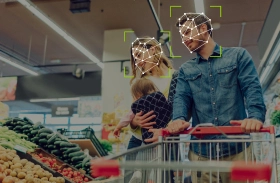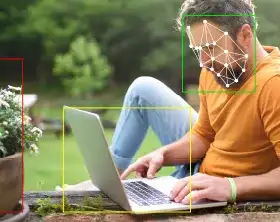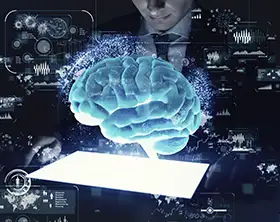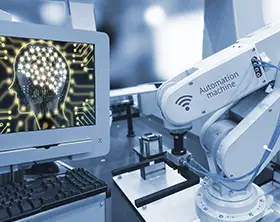How to Estimate the Cost of a Computer Vision Project
The average number of AI capabilities, including natural-language processing and computer vision has doubled from 1.9 in 2018 to 3.8 in 2022. The upward trend is set to continue. The global market for computer vision technology is expected to grow at a CAGR of 7.8% through 2030 to a total value of $22 billion.
The interest in computer vision software is undeniably high, yet the “cost factor” deters some leaders from acting upon it. If you are wondering about the ROI of a computer vision project, this post explains how to make accurate estimates.
4 Factors That Drive Computer Vision Model Costs
Computer vision solutions have two major components:
- Hardware: Cameras, frame grabbers, controllers, and an array of supporting IoT devices for edge processing.
- Software: Custom algorithm or proprietary computer vision API; cloud computing infrastructure for image processing and analysis; supporting monitoring solutions.
What makes cost estimation challenging is that both costs are highly variable and depend on the selected computer vision use case.
To obtain an accurate estimate, we recommend conducting a project discovery — an analysis to identify all requirements for the future system and level-set the design and deployment scenario accordingly.
Hardware Requirements
The costs of computer vision cameras, better known as charge-coupled devices (CCDs), have drastically reduced over the past years, with options available in the $30 to $3,500 range. Still, you may be unpleasantly surprised by the costs of computer vision hardware alone.
Unlike the human eye, a computer vision camera has more limited image capture capabilities and is less effective in complex conditions (e.g., twilight, fog, poor lighting, etc.). A human eye can capture 576 megapixels, whereas high-resolution CDDs average from 2 to 21 megapixels. Therefore, when planning a computer vision project, it is important to realistically estimate how many cameras you will need for the selected use case.
For effective operations, you will need to determine the optimal camera placements to avoid blind zones or environmental backlighting. When deciding on the computer vision camera types, quantity, and placements, evaluate:
- Building structure and possible obstructions
- Lighting conditions at different times of day
- Local privacy rules and regulations
Our computer vision experts always recommend on-site evaluations as these allow the best understanding of the operational conditions.
With hardware, there are always trade-offs in terms of speed, quality, and cost. High-definition, color cameras with high image transfer speeds are better suited for doing inspections on fast production lines, for example. Yet, they are more costly to install and operate.
Likewise, color cameras are often seen as a preferred option. This is often the case for computer vision solutions in the automotive industry such as vehicle detection, lane detection, or obstacle detection. However, a monochrome solution can help optimize costs for computer vision projects, in which color is not important for sensing (e.g., for an automatic license plate recognition scenario).
Overall, we recommend conducting a thorough cost assessment during the planning phase and performing extra estimations when requirements and operating conditions change. For example, changes in a camera-to-focal-point distance or the model accuracy performance will likely trigger new investments in hardware.
Supporting Infrastructure
The second important factor in the total cost of ownership (TCO) for the acquired computer vision technology is image processing infrastructure.
You have two deployment scenarios for computer vision models:
- Cloud
- Edge (local)
A cloud scenario assumes sending individual images via a computer vision API to a remote cloud server for processing (i.e., detection, recognition, and reporting). Popular computer vision APIs include AWS Rekognition, Azure Cognitive Services, and Google Cloud AI Vision.
The downsides of such an approach are:
- Costs. APIs charge per detection, per frame, per unit, or per another dynamic measure. This makes ongoing cost control more challenging as the costs grow exponentially with the processing volumes.
- Latency. Although latency rests in the millisecond range, the delay can still be critical for high-paced production lines or other computer vision use cases, requiring an almost instant response.
Overall, cloud-based processing can be cost-effective for small-scale computer vision projects e.g., a mask wearing detection application for a medium-sized office. However, the TCO can become more inhibiting for more complex projects, requiring a combination of different AI vision tasks (e.g., gesture detection, object recognition, movement tracking, etc.).
For example, when implementing an advanced AI vision system for a retail company, our team opted for on-premises computing and data processing as such infrastructure design allowed better performance and cost efficiency. A locally deployed computer vision system enabled the retailer to perform people counting, customer re-identification, and age/gender recognition in real-time.
Such an edge deployment scenario assumes using local infrastructure (physical computers, servers, or even mobile devices) for processing data on the spot. Edge computer vision systems can continue normal operations even with connectivity disruptions thanks to edge-side buffers and support easy scaling. New edge endpoints can be added or removed without affecting other nodes in the system.
The main constraint of edge model deployment is limited hardware capabilities. Affordable CPU or GPU processors may not be able to support 24/7 operations or handle resource-heavy computer vision models. Whereas specialized AI accelerators (e.g., VPU, TPU, etc.) increase the project costs.
There is also the question of system maintenance. Cloud comes with managed security, whereas local deployments require manual process implementation for effective administration, security, and vulnerability management.
At the project planning stage, we always recommend considering these computer vision implementation challenges. Model how the ongoing operating costs will change depending on the deployment scenario and application architecture design to find the optimal balance of cost vs. performance characteristics. Speaking of which…
Algorithm Complexity
The choice and capacity of a computer vision algorithm will also impact the cost of a computer vision project.
The newer generation of computer vision models, powered by deep neural networks, combine multiple processing steps to deliver higher accuracy. However, they also require more computing resources for effective operations (i.e., more cloud capacities or local GPUs/TPUs). Heavy-weight models also need substantial storage, which makes them not suitable for deployments on mobile devices. Such models demonstrate great potential during proof-of-concept (PoC) deployments but often prove too expensive to scale and operate in real-world settings.
On the other hand, some computer vision algorithms are optimized for high inference speed and are therefore more lightweight. Some models like TensorFlow Mobile and OpenPose Lite are also mobile-friendly as they can run on limited storage.
The tradeoff of lighter models is accuracy. For example, the ResNet50 model has a 76% accuracy rate and MobileNetV2 has a 72% accuracy rate, according to a recent benchmarking. In comparison, heavier computer vision models (e.g., CoCa, BASIC-L), which use more parameters and computing resources, boast accuracy rates of 90% and above.
Remember: Not all computer vision use cases require state-of-the-art processing models. In many cases, a simpler, lightweight model could satisfy all the project requirements and allow cost-effective scaling after a successful pilot stage.
Ongoing Model Performance
Another common estimation trap of computer vision software is inflated ongoing expectations. After seeing an impressive benchmark rate during model training and the PoC stage, some companies may expect the same levels of cutting-edge performance during a scaled deployment.
Yet, data drift is almost inevitable for computer vision projects. Likewise, temporary performance slumps may occur for a variety of issues: system connectivity issues, unaccounted-for lighting conditions, or changes in the detected product design (e.g., switching from blue to yellow labels).
To understand whether your computer vision solution performs within the acceptable range, you should focus on tracking quantitative measures such as:
- Accuracy rates — how well the computer vision model recognizes, classifies, or segments images/videos.
- Precision and recall — a percentage of correctly identified and labeled images or videos.
- Speed — how fast the model processes incoming data.
- Scalability — how well the model handles increased data volumes and multiple sources of input.
To capture the above, you should implement an automatic quality control pipeline for benchmarking the model against realistic targets. With automatic model monitoring, you can avoid chasing edge use cases and temporary performance slumps.
At the end of the day, the ROI of computer vision software is not in its technical characteristics only. You should focus on estimating how the new solution helps you optimize costs, mitigate risks, access new market opportunities, or improve customer service levels.
Conclusion
Computer vision solution costs are largely case-based and driven by the selected use case. To obtain an accurate estimate of the initial investment, model different hardware and software configurations. Deployment scenarios and application design patterns enable different model performance characteristics and operating costs.
Once you have the ballpark implementation and operating costs, stack these against the value you can obtain: Reduction in manual labor, improvements in operating speeds, product quality, or customer service upgrades — and you will get your ROI number.










